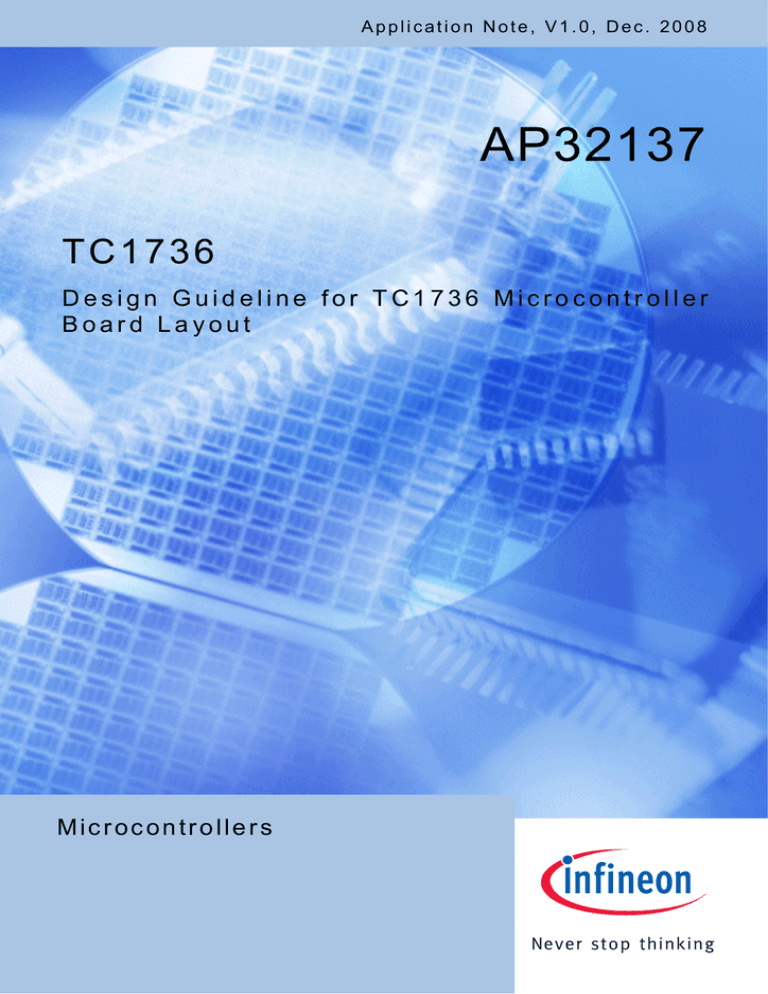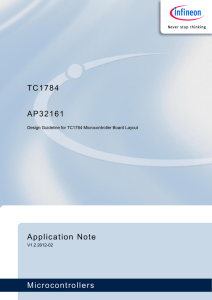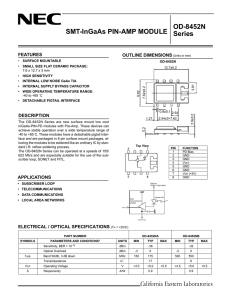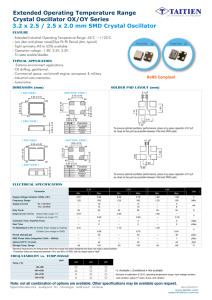
Application Note, V1.0, Dec. 2008
AP32137
TC1736
Design Guideline for TC1736 Microcontroller
Board Layout
Microcontrollers
Edition 2008-12-18
Published by
Infineon Technologies AG
81726 München, Germany
© Infineon Technologies AG 2008.
All Rights Reserved.
LEGAL DISCLAIMER
THE INFORMATION GIVEN IN THIS APPLICATION NOTE IS GIVEN AS A HINT FOR THE
IMPLEMENTATION OF THE INFINEON TECHNOLOGIES COMPONENT ONLY AND SHALL NOT BE
REGARDED AS ANY DESCRIPTION OR WARRANTY OF A CERTAIN FUNCTIONALITY, CONDITION OR
QUALITY OF THE INFINEON TECHNOLOGIES COMPONENT. THE RECIPIENT OF THIS APPLICATION
NOTE MUST VERIFY ANY FUNCTION DESCRIBED HEREIN IN THE REAL APPLICATION. INFINEON
TECHNOLOGIES HEREBY DISCLAIMS ANY AND ALL WARRANTIES AND LIABILITIES OF ANY KIND
(INCLUDING WITHOUT LIMITATION WARRANTIES OF NON-INFRINGEMENT OF INTELLECTUAL
PROPERTY RIGHTS OF ANY THIRD PARTY) WITH RESPECT TO ANY AND ALL INFORMATION GIVEN
IN THIS APPLICATION NOTE.
Information
For further information on technology, delivery terms and conditions and prices please contact your nearest
Infineon Technologies Office (www.infineon.com).
Warnings
Due to technical requirements components may contain dangerous substances. For information on the types
in question please contact your nearest Infineon Technologies Office.
Infineon Technologies Components may only be used in life-support devices or systems with the express
written approval of Infineon Technologies, if a failure of such components can reasonably be expected to
cause the failure of that life-support device or system, or to affect the safety or effectiveness of that device or
system. Life support devices or systems are intended to be implanted in the human body, or to support
and/or maintain and sustain and/or protect human life. If they fail, it is reasonable to assume that the health
of the user or other persons may be endangered.
AP32137
Design Guideline for TC1736 Microcontroller Board Layout
AP32137
Revision History:
2008-12
V1.0
Previous Version:
Page
Subjects (major changes since last revision)
We Listen to Your Comments
Any information within this document that you feel is wrong, unclear or missing at all?
Your feedback will help us to continuously improve the quality of this document.
Please send your proposal (including a reference to this document) to:
mcdocu.comments@infineon.com
Application Note
3
V1.0, 2008-12
AP32137
Design Guideline for TC1736 Microcontroller Board Layout
Table of Contents
Page
1
1.1
1.2
Overview ........................................................................................................................................5
General Informations:......................................................................................................................5
Pinout of TC1736 ............................................................................................................................5
2
2.1
2.2
PCB Design Recommendations ..................................................................................................6
Decoupling ......................................................................................................................................8
Decoupling Capacitor List: ............................................................................................................10
Application Note
4
V1.0, 2008-12
AP32137
Design Guideline for TC1736 Microcontroller Board Layout
Overview
1
Overview
The TC1736 is a 32-Bit microcontroller in TQFP-144-pin package, which requires a carefully designed PCB
concerning electromagnetic compatibility. In additionl to the Infineon PCB Design Guidelines for Microcontrollers
(AP24026), which gives general design rule informations for PCB design, some product-specific
recommendations and guidelines for TC1736 are discussed here.
1.1
General Informations:
The microcontroller has three supply domains (VDD = 1.5V for Core, VDDP = 3.3V for I/O Pad, VDDM = 3.3V or
5V for ADC), which should be decoupled individually.
The power supply feeding from the regulator outputs to each domain can be made on a supply layer (POWER).
VDDFL3
VSS
VDDP
VSS
VDDP
VDD
VDDP
VDD
Pinout of TC1736
VSS
1.2
VSS
VDDP
VDD
VDD
VDDP
VSS
TC1736
VDDP
VDD
VSS
VDDAF
VDDOSC3
VDDOSC
VDDMF
VSSMF
VSSOSC
XTAL2
XTAL1
VFAREF
VFAGND
VSS
Figure 1
VSS
VDDP
VDD
VDD
VSS
VDDP
VAGND0
VAREF0
VSSM
VDDM
VDDP
VDD
Pinout of TC1736 (TQFP-144):
Application Note
5
V1.0, 2008-12
AP32137
Design Guideline for TC1736 Microcontroller Board Layout
PCB Design Recommendations
2
PCB Design Recommendations
!
To minimize the EMI radiation on the PCB the following signals have to be considered as critical:
-
SYSCLK: System clock output
-
Supply pins
Route these signals with adjacent ground reference and avoid signal and reference layer changes.
Route them as short as possible.
Routing ground on each side can help to reduce coupling to other signals.
!
For unused “Output, Supply, Input and I/O “ pins following points must be considered:
1. Supply Pins (Modules) :
• See the User´s Manual.
2. I/O-Pins:
•
Should be configured as output and driven to static low in the
weakest driver mode in order to improve EMI behaviour.
Configuration of the I/O as input with pullup is also possible.
•
Solderpad should be left open and not be connected to any
other net (layout isolated PCB-pad only for soldering).
•
Should be driven static in the weakest driver mode.
•
If static output level is not possible, the output driver should
be disabled.
•
Solderpad should be left open and not be connected to any
other net (layout isolated PCB-pad only for soldering).
•
For pins with alternate function see product
specification to define the necessary logic level.
•
Should be connected with high-ohmic resistor to GND (range
10k – 1Meg) wherever possible. No impact on design is
however expected if a direct connection to GND is made.
•
Groups of 8 pins can be used to reduce number of external
pull-up/down devices (keep in mind leakage current).
•
For pins with alternate function see product specification to
define the necessary logic level
•
Should be configured as pull-down and should be activated
static low (exception: if the User´s Manual requires high level
for alternate functions). No impact on design is expected if
static high level is activated.
•
Solderpad should not be connected to any other net (isolated
PCB-pad only for soldering)
3. Output Pins :
4.Input Pins without internal pull
device:
5. Input Pins with internal pull
device:
!
target
The ground system must be designed as follows:
- Separate analog and digital grounds.
- The analog ground must be separated into two groups:
1. Ground for OSC and PLL (VSSOSC for VDDOSCand VDDOSC3) as common star point.
2. Ground for ADC (VSSM for VDDM, VSSMF for VDDMF/VDDAF) as common star point.
!
To reduce the radiation / coupling from oscillator circuit, a separated ground island on the GND layer
should be made. This ground island can be connected at one point to the GND layer. This helps to keep
noise generated by the oscillator circuit locally on this separated island. The ground connections of the
Application Note
6
V1.0, 2008-12
AP32137
Design Guideline for TC1736 Microcontroller Board Layout
PCB Design Recommendations
load capacitors and VSSOSC should also be connected to this island. Traces for load capacitors and
Xtal should be as short as possible.
!
The power distribution from the regulator to each power plane should be made over filters (EMI filter
using ferrite beads).
!
RC Filters can be inserted in the supply paths at the regulator output and at the branchings to other
module supply pins like VDDOSC, VDDOSC3, VDDFL3, VDDMF, and VDDAF. Using inductance or
ferrite beads (5 – 10 µH) instead of the resistors can improve the EME behaviour of the circuit and
reduce the radiation up to ~10dBµV on the related supply net. (See Figure 2).
!
OCDS must be disabled.
!
Select weakest possible driver strengths and slew rates for all I/Os (see Scalable Pads AppNote
AP32111).
!
Use lowest possible frequency for SYSCLK.
!
Avoid cutting the GND plane by via groups. A solid GND plane must be designed.
VDD (1.5V)
VDDP (3.3V)
R=10
VDDOSC3
VDDOSC
330 nF
VSS
R=10
330 nF
VSSOSC
VSSOSC
VDD (1.5V)
R*
VDDAF
47 nF
µC
2 x 47 nF
VSS
[5V or 3.3V]
R*
VDDP (3.3V)
VDDFL3
VSS
VDDMF
VDDM
R*
[3.3V]
47 nF
47 nF
VSSM
VSSMF
* Resistance values must be calculated according to the application curcuit tolerances.
Figure 2
Filtering of VDDOSC, VDDOSC3, VDDFL3, VDDM, VDDMF, VDDAF supply pins
Application Note
7
V1.0, 2008-12
AP32137
Design Guideline for TC1736 Microcontroller Board Layout
PCB Design Recommendations
2.1
Decoupling
!
The two supply domains VDD and VDDP of TC1736 should be decoupled separately (see
decoupling layout example in Figure 3).
!
Type of capacitors:
–
Values: 47 nF, 330 nF
–
X7R Ceramic Multilayer (Low ESR and low ESL)
!
All supply pins should be connected first to the dedicated decoupling capacitor and then from the
capacitors over vias to the power planes.
!
All VSS pins should be connected to the GND layer.
!
The decoupling capacitors should be placed directly under the IC or if necessary, some capacitors
can be placed on top layer close to the supply pins of the IC.
!
Ground plane on bottom layer can be used to connect the capacitors. If no plane is used, they
should be connected with vias to the GND layer.
!
Multiple vias should be used at capacitors to get a low impedance connection between capacitors
and power/GND planes or pins.
!
All capacitors must be placed as close as possible to the related supply pin group.
A power-plane/grounding concept example for a 32-bit microcontroller like TC1736 with TQFP-144 package
can be seen in Figure 3. Alternative implementations are also acceptable and must be evaluated within
application by customer.
Capacitors on top layer (VDDP)
Signal/GND
Signal/Power
Capacitors on bottom layer (VDD)
VDDP from VR
on bottom layer
GND from VR
On toplayer
TC1736
GND from VR
On toplayer
Analog Ground on Toplayer
Figure 3
See Figure 4
for Oscillator Circuit
VDD from VR
On Bottom layer
Layout example for decoupling of TC1736 (LQFP-176)
Application Note
8
V1.0, 2008-12
AP32137
Design Guideline for TC1736 Microcontroller Board Layout
PCB Design Recommendations
GND
Crystal
Separated GND
island on toplayer
(carved out from
global GND layer)
Load capacitors
Vias to GND island
XTALin/out
VSSosc
Via to global
GND layer
Figure 4
µC
Layout proposal oscillator circuit
Application Note
9
V1.0, 2008-12
AP32137
Design Guideline for TC1736 Microcontroller Board Layout
PCB Design Recommendations
2.2
Decoupling Capacitor List:
Capacitor
Supply
Pins(TQFP-144)
47nF
47nF
47nF
47nF
47nF
47nF
47nF
47nF
47nF
47nF
47nF
47nF
47nF
47nF
47nF
47nF
47nF
47nF
330 nF
330 nF
47 nF
47 nF
47 nF
VDDP
VDDP
VDDP
VDDP
VDDP
VDDP
VDDP
VDDP
VDDP
VDD
VDD
VDD
VDD
VDD
VDD
VDD
VDD
VDDFL3
VDDOSC
VDDOSC3
VDDAF
VDDMF
VDDM
13
22
59
69
79
100
115
126
139
12
23
58
70
78
99
125
138
117
84
85
25
26
44
Note: This application note contains design recommendations from Infineon
Technologies point of view. Effectiveness and performance of the final application
implementation must be validated by customer, based on dedicated implementation
choices.
Application Note
10
V1.0, 2008-12
http://www. inf ineon.com
Published by Infineon Technologies AG






